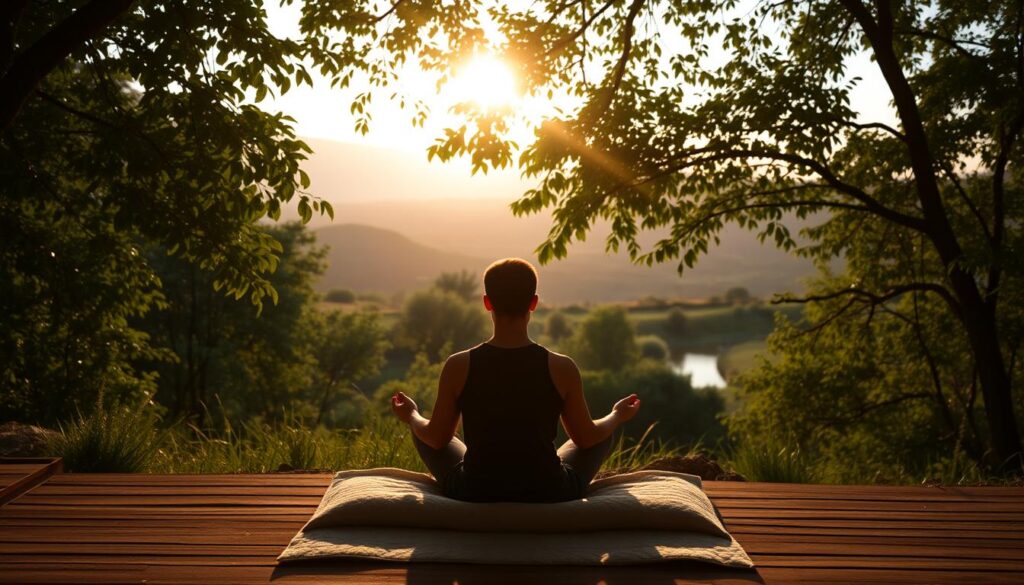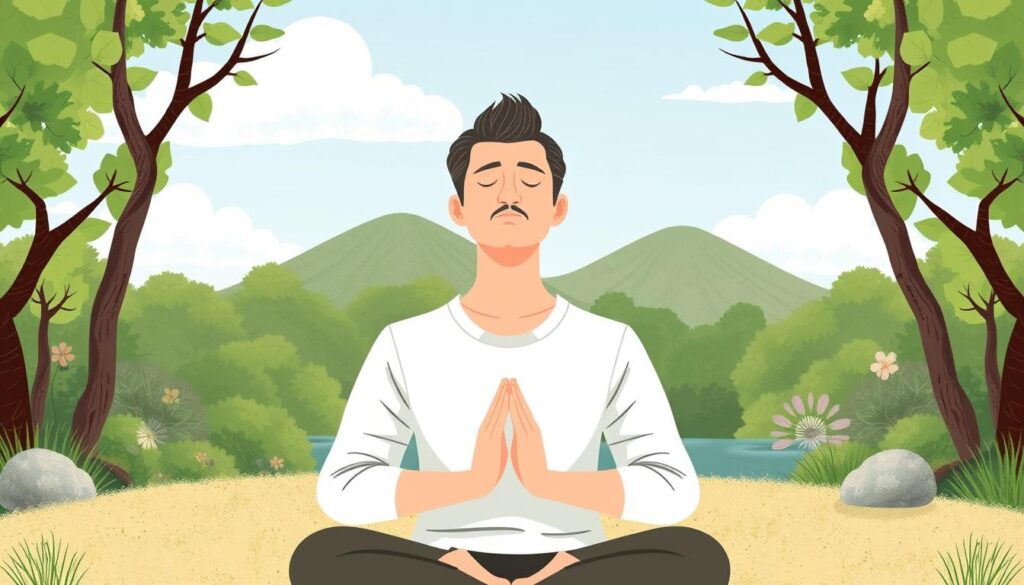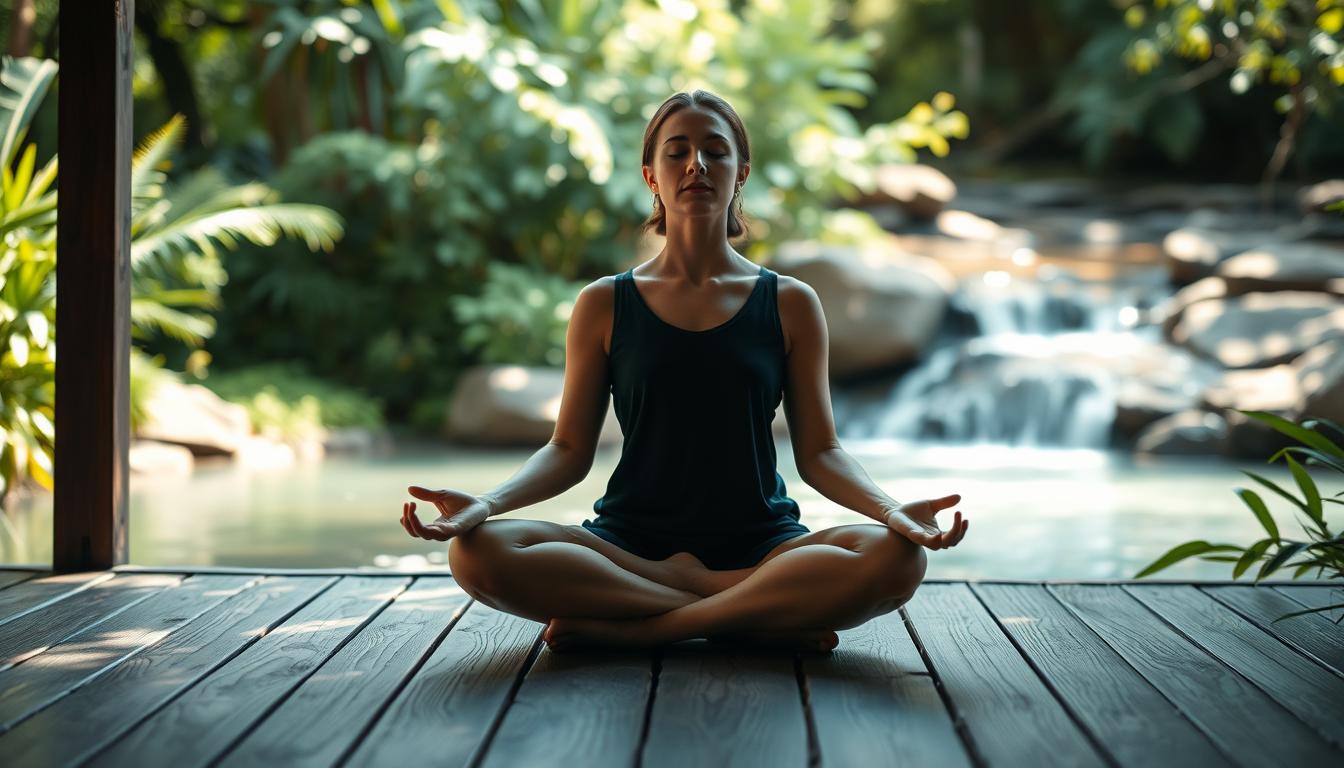In today’s fast-paced world, it’s easy to get caught up in the hustle and bustle of daily life. As someone who’s been there, I can attest that incorporating mindfulness into your daily routine can be a game-changer. That’s where online meditation comes in – a simple, accessible way to cultivate calm and clarity.
Even short sessions of meditation can have a significant impact on both mental and physical health. By dedicating just a few minutes a day to this practice, you can experience the numerous benefits of meditation, from reduced stress to improved focus.
Key Takeaways
- Discover how to incorporate meditation into your busy lifestyle
- Learn practical, beginner-friendly approaches to mindfulness
- Understand the science-backed benefits of regular meditation practice
- Find out how consistency matters more than duration in meditation
- Explore how online meditation can transform your relationship with stress
The Power of Short Meditation
The power of short meditation lies in its ability to bring balance to our chaotic lives, one brief moment at a time. In a world where time is scarce, dedicating just a few minutes to meditation can have a profound impact on both mind and body.
Why Frequency Matters More Than Duration
When it comes to meditation, the common misconception is that longer sessions are more beneficial. However, research suggests that frequency is more important than duration. Engaging in short, daily meditation practices can lead to greater benefits than infrequent, lengthy sessions. This approach helps in developing consistency, which is key to experiencing the positive effects of meditation on a regular basis.
By incorporating short meditation sessions into your daily routine, you can better manage stress and enhance your overall health. The cumulative effect of frequent, brief meditation practices contributes to improved mental clarity and a stronger body, fostering a sense of well-being and resilience.
Scientific Benefits of Brief Meditation Sessions
Studies have shown that even brief meditation sessions can have a significant impact on both mind and body. These sessions have been linked to reduced cortisol levels, improved focus, and enhanced emotional regulation. Regular brief meditation practices can lead to changes in brain regions associated with self-awareness and compassion, contributing to a more balanced and healthy life.
Furthermore, the benefits of short meditation extend to improved sleep quality, immune function, and cardiovascular health. By building resilience through consistent practice, individuals can better cope with future stressors, underscoring the value of incorporating short meditation into daily life.
Understanding Short Meditation
Meditation doesn’t have to be a lengthy process; short meditation sessions can be just as effective. In fact, incorporating short meditation into your daily routine can have a significant impact on both your mental and physical well-being.
What Defines a Short Meditation Practice
A short meditation practice typically ranges from a few minutes to about 20 minutes. It’s about finding a moment of calm and clarity in your busy day. Even five minutes of meditation can be beneficial, allowing you to reset your nervous system and approach challenges with a clearer mind. This brief pause can help you become more aware of your thoughts and emotions, making it easier to manage stress.
How Even Five Minutes Can Transform Your Day
Starting your day with a short meditation can set a positive tone. It helps you focus on the present moment, preparing you to tackle tasks with a clearer and more focused mind and body. By doing so, you’re more likely to feel calmer and more composed throughout the day. This simple practice can also help break negative thought patterns, creating a “pattern interrupt” that prevents stress from accumulating.
By incorporating short meditation into your daily routine, you can experience these benefits firsthand. It’s a simple yet effective way to enhance your mental resilience and overall well-being.
Getting Started: The Basics of Short Meditation
Embarking on a meditation practice can be as simple as dedicating a few minutes each day to quiet reflection. As we begin this journey, let’s cover some essential basics that will help you establish a strong foundation for your short meditation practice.
Finding Your Comfortable Position
Finding a comfortable position is crucial for meditation. You can sit on a chair, on a cushion on the floor, or even lie down – the key is to maintain a posture that allows you to relax and keep your body relaxed. For beginners, starting with a simple position like sitting with your back straight and hands placed gently on your lap can be a good starting point.
Setting Realistic Time Expectations
As a beginner, it’s essential to set realistic time expectations. Start with short periods, like 2-5 minutes, and gradually increase as you become more comfortable with the practice. This will help you stay motivated and avoid feeling overwhelmed.
Creating Your Meditation Space
Creating a dedicated meditation space can help you establish a consistent practice. Identify a quiet area where you can sit comfortably without distractions. You can make this space more inviting by adding elements like a meditation cushion, a few plants, or calming artwork – the goal is to create an environment that promotes relaxation and helps calm your mind.
Essential Breathing Techniques for Beginners
Let’s dive into some essential breathing techniques. Focusing on your breath is a fundamental aspect of meditation. Take deep breaths, feeling the sensation of the air entering and leaving your body. Try to focus on your breath, noticing the natural rhythm of your inhales and exhales. For example, you can practice diaphragmatic breathing by taking deep inhales that expand your belly, followed by slow exhales that contract it. A simple technique is the 4-7-8 method: inhale for 4 seconds, hold for 7, and exhale for 8. This can help calm your mind and bring you to the present moment.

As you practice, you may find your mind wandering. Gently bring your attention back to your breath. Here are some additional techniques to help you get started:
- Notice the sensation of your breath in your body
- Use counting to help maintain focus on your breath
- Practice observing your breath without trying to control it
Use the 4-7-8 breathing technique to calm your nervous system
As you continue to practice, you’ll find that these simple techniques can have a significant impact on your daily life, helping you stay calm and focused. Here is a simple table outlining the steps for the 4-7-8 breathing technique:
| Step | Action | Duration |
|---|---|---|
| 1 | Inhale | 4 seconds |
| 2 | Hold | 7 seconds |
| 3 | Exhale | 8 seconds |
5 Simple Short Meditation Techniques for Busy People
For those with hectic schedules, here are five simple meditation techniques that can be practiced in just a few minutes a day.
These short meditation techniques are designed to help you relax, reduce stress, and improve your overall well-being, even in the midst of a busy life.

Mindful Breathing (5-Minute Practice)
Mindful breathing is a simple yet powerful technique that involves focusing on your breath to bring your attention to the present moment. To practice, sit comfortably, close your eyes, and take slow, deep breaths, focusing on the sensation of the breath moving in and out of your body. As you do this, you can relax your body and let go of stress. You can find more information on this technique and other meditation practices in our article on meditation in the modern age.
Body Scan Meditation (3-Minute Version)
Body scan meditation involves paying attention to different parts of your body, starting from your head and moving down to your toes, and releasing any tension as you go. This technique can help you become more aware of your bodily sensations and relax your overall physical state. As you practice, take deep breaths and imagine any tension leaving your body.
Walking Meditation for Active Minds
Walking meditation is a technique that combines physical movement with mindfulness. To practice, walk slowly and deliberately, paying attention to the sensation of your feet touching the ground, the movement of your legs, and the rhythm of your breath. This technique can help you cultivate mindfulness while being physically active.
Loving-Kindness Quick Practice
Loving-kindness meditation involves focusing on sending kindness to yourself and others. To practice, start by directing kindness towards yourself, then gradually extend it to others, including those you may have difficulty with. This technique can help cultivate a sense of compassion and empathy.
Tension Release Meditation
Tension release meditation is a technique that involves visualizing tension leaving your body as you breathe out. As you take deep breaths, imagine any stress or tension melting away, leaving your body relaxed and at ease. This practice can be especially helpful for managing stress and promoting relaxation.
Incorporating Short Meditation Into Your Daily Routine
Incorporating short meditation into your daily routine can be a game-changer for your mental and physical well-being. By making meditation a habit, you can experience a profound difference in your day and overall quality of life.
Morning Meditation Rituals
Starting your day with a short meditation can relieve early morning grogginess and offer an alternative to scrolling through social media feeds first thing. Take a minute before you get out of bed to practice a short morning meditation to help find your focus for the day ahead. This simple practice can calm your mind and prepare your body for the day’s challenges.

Midday Reset Practices
When you need a break, a short meditation session can help you reset and recharge. Take a few minutes to focus on your breath, relax your body, and calm your mind. This midday reset can improve your productivity and help you tackle the rest of your day with renewed energy.
Evening Wind-Down Techniques
In the evening, meditation can help you unwind and prepare for a restful night’s sleep. By incorporating a short meditation practice into your pre-sleep routine, you can calm your nervous system, release the day’s tensions, and relax your body. This can lead to improved sleep quality and a more refreshed feeling in the morning.
Common Challenges and How to Overcome Them
Starting a meditation practice is just the beginning; the real work lies in overcoming the hurdles that come with it. As you continue on your meditation journey, you’ll likely face several common challenges that can test your resolve.
Dealing With a Wandering Mind
One of the most common challenges is dealing with a wandering mind. It’s easy to get frustrated when your mind won’t settle, but the key is to be patient and gentle with yourself. Try acknowledging the thought and letting it go, rather than engaging with it. With consistent meditation practice, you’ll find it easier to focus.
Finding Time in a Busy Schedule
Finding time to meditate can be tough, especially when life gets busy. However, even a few minutes of meditation every day can be beneficial. Try incorporating it into your daily routine, like right after waking up or before bed. You can also use a meditation app to guide you and keep you on track.
Managing Expectations and Progress
It’s easy to get discouraged if you feel like you’re not making progress in your meditation practice. The truth is, progress is not always linear. Some days will be easier than others, and that’s okay. The important thing is to stay consistent and celebrate small victories along the way.
Staying Consistent With Your Practice
To stay consistent, try to meditate at the same time every day. You can also use reminders or find a meditation buddy to keep you accountable. Remember, the goal is to make meditation a habit, so be gentle with yourself if you miss a day or two. With time, it will become a non-negotiable part of your daily routine, like brushing your teeth.
Enhancing Your Short Meditation Practice
As you establish your short meditation practice, you might find it helpful to explore additional tools that can enhance your experience. While the core of meditation remains the same, certain aids can support your journey, especially when you’re just starting out or looking to deepen your practice.
Helpful Apps and Online Resources
There are numerous apps and online resources designed to support your meditation practice. Some popular options include guided meditation apps that offer short sessions tailored to various needs and moods.
For instance, Headspace is a well-known app that provides personalized meditation sessions. You can try it out by visiting their website or downloading the app.

Using Music and Aromatherapy
Incorporating music and aromatherapy into your meditation practice can be a powerful way to enhance your experience. Soothing music can help create a calming atmosphere, while certain scents like lavender can promote relaxation.
When selecting music, opt for calming, instrumental tracks that won’t distract you from your meditation. For aromatherapy, start with a single scent and see how it affects your practice. These elements can serve as anchors for your attention, especially when you’re beginning your meditation journey.
Remember, the key is to use these tools to support, not replace, your core mindfulness techniques. As you become more comfortable with meditation, you can gradually adjust your use of these aids to find what works best for you.
Conclusion: Building Resilience Through Consistent Short Meditation
By embracing short meditation, you’re not just adopting a practice – you’re cultivating a life skill that fosters resilience and mindfulness. This simple yet powerful tool can transform your relationship with life’s challenges, helping you respond rather than react. Start with one technique that resonates with you, and watch how regular meditation can positively impact all areas of your life. Begin your journey now – take one minute to breathe mindfully.
FAQ
How do I start a mindfulness practice when I’m extremely busy?
Begin by committing to just a few deep breaths a day, ideally at the same time each day, such as during your morning routine or right before a meeting. You can also try incorporating mindfulness meditation into your daily activities, like eating or walking.
Can walking meditation really help reduce stress?
Yes, walking meditation can be a great way to reduce stress while also getting some physical activity. By focusing on the sensations in your feet and the movement of your body, you can bring your attention to the present moment and let go of worries about the past or future.
How can I make my meditation practice more consistent?
To make your practice more consistent, try setting a specific time and place for it each day, and use reminders or cues like a meditation app or a calming scent to help you stay on track. You can also experiment with different types of meditation, such as loving-kindness or body scan, to keep your practice interesting.
What are some common challenges people face when starting a meditation practice, and how can they overcome them?
One common challenge is dealing with a wandering mind. When you notice your mind drifting away, gently bring your focus back to your breath or the present moment. Another challenge is finding time – try incorporating meditation into your daily routine, like right after waking up or before bed.
Can meditation really improve my relationships?
Yes, by cultivating a greater sense of self-awareness, patience, and compassion through meditation, you can become more understanding and empathetic towards others, leading to more harmonious and meaningful relationships.
How can I use music or other sensory elements to enhance my meditation experience?
You can use calming music, nature sounds, or aromatherapy to create a peaceful atmosphere that fosters relaxation and focus. Experiment with different sounds, scents, or visuals to find what works best for you.
